核电厂安全分析
核电厂事故案例分析与教训
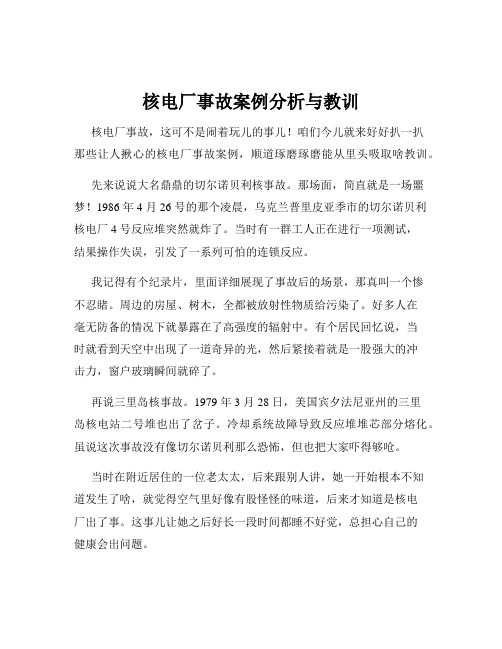
核电厂事故案例分析与教训核电厂事故,这可不是闹着玩儿的事儿!咱们今儿就来好好扒一扒那些让人揪心的核电厂事故案例,顺道琢磨琢磨能从里头吸取啥教训。
先来说说大名鼎鼎的切尔诺贝利核事故。
那场面,简直就是一场噩梦!1986 年 4 月 26 号的那个凌晨,乌克兰普里皮亚季市的切尔诺贝利核电厂 4 号反应堆突然就炸了。
当时有一群工人正在进行一项测试,结果操作失误,引发了一系列可怕的连锁反应。
我记得有个纪录片,里面详细展现了事故后的场景,那真叫一个惨不忍睹。
周边的房屋、树木,全都被放射性物质给污染了。
好多人在毫无防备的情况下就暴露在了高强度的辐射中。
有个居民回忆说,当时就看到天空中出现了一道奇异的光,然后紧接着就是一股强大的冲击力,窗户玻璃瞬间就碎了。
再说三里岛核事故。
1979 年 3 月 28 日,美国宾夕法尼亚州的三里岛核电站二号堆也出了岔子。
冷却系统故障导致反应堆堆芯部分熔化。
虽说这次事故没有像切尔诺贝利那么恐怖,但也把大家吓得够呛。
当时在附近居住的一位老太太,后来跟别人讲,她一开始根本不知道发生了啥,就觉得空气里好像有股怪怪的味道,后来才知道是核电厂出了事。
这事儿让她之后好长一段时间都睡不好觉,总担心自己的健康会出问题。
这些事故带来的后果那可太严重了。
首先就是人员伤亡。
好多在事故现场的工人,还有周边无辜的居民,都因为受到了大量的辐射,患上了各种各样的重病,甚至失去了生命。
而且,核辐射这玩意儿可不是一时半会儿就能消失的,它会长期影响当地的生态环境。
土地被污染了,种不了庄稼;河水被污染了,鱼也没法生存。
那咱们能从这些惨痛的事故中吸取啥教训呢?第一,操作一定要规范!那些工人在操作的时候但凡能严格按照流程来,也许很多事故就能避免。
就像咱们平时做数学题,步骤错了,答案能对吗?第二,安全设备得靠谱!核电厂的那些冷却系统、防护装置啥的,必须得经常检查、维护,关键时刻可不能掉链子。
第三,应急响应要迅速。
一旦出了事,得马上有一套有效的应对措施,不能手忙脚乱的。
核电厂危险化学品的危险性分析及安全措施
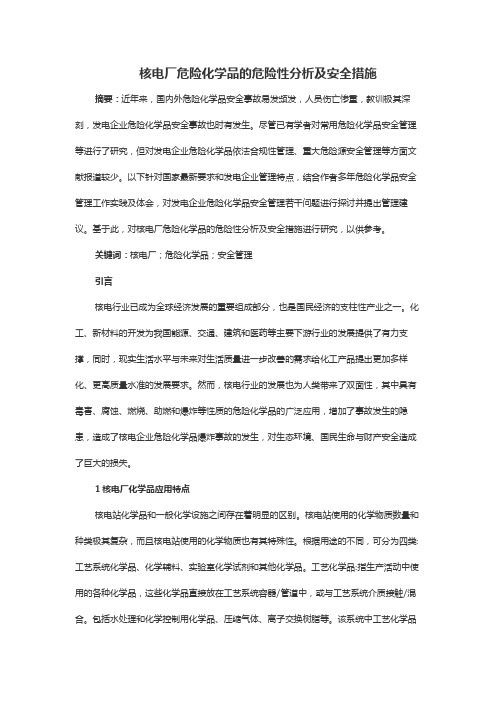
核电厂危险化学品的危险性分析及安全措施摘要:近年来,国内外危险化学品安全事故易发频发,人员伤亡惨重,教训极其深刻,发电企业危险化学品安全事故也时有发生。
尽管已有学者对常用危险化学品安全管理等进行了研究,但对发电企业危险化学品依法合规性管理、重大危险源安全管理等方面文献报道较少。
以下针对国家最新要求和发电企业管理特点,结合作者多年危险化学品安全管理工作实践及体会,对发电企业危险化学品安全管理若干问题进行探讨并提出管理建议。
基于此,对核电厂危险化学品的危险性分析及安全措施进行研究,以供参考。
关键词:核电厂;危险化学品;安全管理引言核电行业已成为全球经济发展的重要组成部分,也是国民经济的支柱性产业之一。
化工、新材料的开发为我国能源、交通、建筑和医药等主要下游行业的发展提供了有力支撑,同时,现实生活水平与未来对生活质量进一步改善的需求给化工产品提出更加多样化、更高质量水准的发展要求。
然而,核电行业的发展也为人类带来了双面性,其中具有毒害、腐蚀、燃烧、助燃和爆炸等性质的危险化学品的广泛应用,增加了事故发生的隐患,造成了核电企业危险化学品爆炸事故的发生,对生态环境、国民生命与财产安全造成了巨大的损失。
1核电厂化学品应用特点核电站化学品和一般化学设施之间存在着明显的区别。
核电站使用的化学物质数量和种类极其复杂,而且核电站使用的化学物质也有其特殊性。
根据用途的不同,可分为四类:工艺系统化学品、化学辅料、实验室化学试剂和其他化学品。
工艺化学品:指生产活动中使用的各种化学品,这些化学品直接放在工艺系统容器/管道中,或与工艺系统介质接触/混合。
包括水处理和化学控制用化学品、压缩气体、离子交换树脂等。
该系统中工艺化学品的不当使用可能导致传统水和蒸汽质量下降,危害蒸汽发生器传热管道的可靠性。
部分部件将为核岛生产额外的中子活化产品,增加初级循环中的放射性污染等,会对核电系统和设备造成损害。
化学辅料:指发电厂生产活动期间可能接触工艺系统中介质的化学品,包括kleb密封剂、清洁和除污产品、颜色/稀释剂、标记产品/胶带剂、研磨辅料等。
核电厂地震安全性分析

核电厂地震安全性分析核电厂作为一种重要的能源供应方式,在我国的发展中发挥着不可替代的作用。
然而,地震作为一种自然灾害,不可避免地会对核电厂的安全性产生影响。
因此,对核电厂地震安全性进行深入分析,具有极其重要的现实意义。
地震是一种破坏性极强的地质灾害,其对建筑物和设施的破坏程度取决于地震烈度以及建筑物自身的抗震能力。
而对于核电厂这种高风险、高敏感性的设施来说,地震可能带来的后果更加严重。
因此,核电厂地震安全性的分析至关重要。
首先,影响核电厂地震安全性的因素有很多。
包括地震烈度、地质构造、地震烈度剧烈程度和频率等。
在设计核电厂时,必须充分考虑这些因素,确保核电厂在面对地震时能够确保人员和设施的安全。
其次,核电厂地震安全性分析的方法也是多种多样的。
通常采用的方法有地震动力学分析、地震时程分析、地震容许性分析等。
这些方法可以帮助我们更加全面地了解核电厂在地震条件下的动态响应特性,进而评估核电厂的地震安全性。
另外,对于核电厂地震安全性分析来说,还需要考虑到不同级别的地震条件下核电厂的抗震能力和安全性。
一般来说,核电厂会根据设计基准地震烈度进行设计,同时进行更严格的后备设计,以确保核电厂在地震时能够安全稳定地运行。
需要指出的是,地震风险的不确定性是核电厂地震安全性分析中一个很重要的问题。
地震是一种地质灾害,其具有瞬时性和不可预测性。
因此,如何准确评估核电厂在地震条件下的安全性,是一个需要不断完善和改进的领域。
综合以上所述,核电厂地震安全性分析是一个复杂而又重要的研究领域。
只有不断加强对核电厂地震安全性的研究,才能够保障核电厂在面对地震时的安全性,确保核电厂持续稳定地运行,为国家的能源供应做出重要贡献。
核电厂运行安全常见问题及防控分析 丁亮
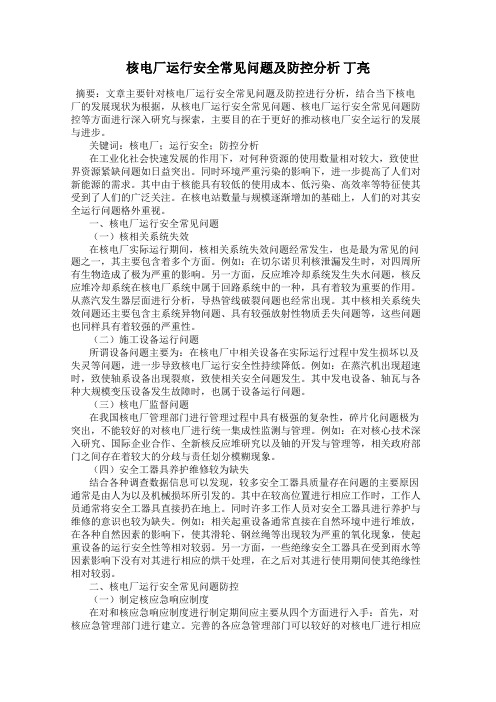
核电厂运行安全常见问题及防控分析丁亮摘要:文章主要针对核电厂运行安全常见问题及防控进行分析,结合当下核电厂的发展现状为根据,从核电厂运行安全常见问题、核电厂运行安全常见问题防控等方面进行深入研究与探索,主要目的在于更好的推动核电厂安全运行的发展与进步。
关键词:核电厂;运行安全;防控分析在工业化社会快速发展的作用下,对何种资源的使用数量相对较大,致使世界资源紧缺问题如日益突出。
同时环境严重污染的影响下,进一步提高了人们对新能源的需求。
其中由于核能具有较低的使用成本、低污染、高效率等特征使其受到了人们的广泛关注。
在核电站数量与规模逐渐增加的基础上,人们的对其安全运行问题格外重视。
一、核电厂运行安全常见问题(一)核相关系统失效在核电厂实际运行期间,核相关系统失效问题经常发生,也是最为常见的问题之一,其主要包含着多个方面。
例如:在切尔诺贝利核泄漏发生时,对四周所有生物造成了极为严重的影响。
另一方面,反应堆冷却系统发生失水问题,核反应堆冷却系统在核电厂系统中属于回路系统中的一种,具有着较为重要的作用。
从蒸汽发生器层面进行分析,导热管线破裂问题也经常出现。
其中核相关系统失效问题还主要包含主系统异物问题、具有较强放射性物质丢失问题等,这些问题也同样具有着较强的严重性。
(二)施工设备运行问题所谓设备问题主要为:在核电厂中相关设备在实际运行过程中发生损坏以及失灵等问题,进一步导致核电厂运行安全性持续降低。
例如:在蒸汽机出现超速时,致使轴系设备出现裂痕,致使相关安全问题发生。
其中发电设备、轴瓦与各种大规模变压设备发生故障时,也属于设备运行问题。
(三)核电厂监督问题在我国核电厂管理部门进行管理过程中具有极强的复杂性,碎片化问题极为突出,不能较好的对核电厂进行统一集成性监测与管理。
例如:在对核心技术深入研究、国际企业合作、全新核反应堆研究以及铀的开发与管理等,相关政府部门之间存在着较大的分歧与责任划分模糊现象。
(四)安全工器具养护维修较为缺失结合各种调查数据信息可以发现,较多安全工器具质量存在问题的主要原因通常是由人为以及机械损坏所引发的。
核电厂安全分析报告的格式和内容
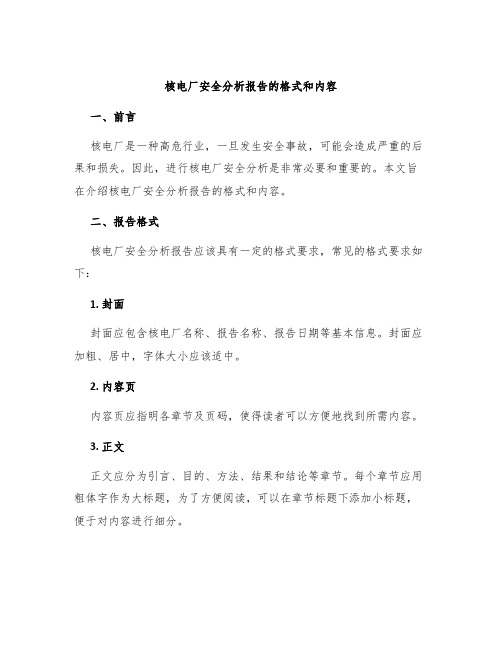
核电厂安全分析报告的格式和内容一、前言核电厂是一种高危行业,一旦发生安全事故,可能会造成严重的后果和损失。
因此,进行核电厂安全分析是非常必要和重要的。
本文旨在介绍核电厂安全分析报告的格式和内容。
二、报告格式核电厂安全分析报告应该具有一定的格式要求,常见的格式要求如下:1. 封面封面应包含核电厂名称、报告名称、报告日期等基本信息。
封面应加粗、居中,字体大小应该适中。
2. 内容页内容页应指明各章节及页码,使得读者可以方便地找到所需内容。
3. 正文正文应分为引言、目的、方法、结果和结论等章节。
每个章节应用粗体字作为大标题,为了方便阅读,可以在章节标题下添加小标题,便于对内容进行细分。
4. 参考文献参考文献应列在报告的最后一页,一般应按照国家或行业相关标准规定进行排版。
参考文献应按照主要作者姓氏的首字母顺序排列,并且应采用标准的引用格式。
三、报告内容核电厂安全分析报告主要包括如下内容:1. 引言在引言中,应对核电厂所在地、建厂时间、建设目的、建设背景等进行简要介绍。
同时,引言还应针对本次的安全分析,说明分析的目的、意义及预期效果。
2. 目的说明本次核电厂安全分析的目的,可以从以下几个方面进行论述:•阐明核电厂的安全问题和现状;•评价核电厂安全防护措施的有效性;•发现并解决核电厂存在的安全隐患;•协助国家行政机关和管理部门规划和监管核电厂的安全管理。
3. 方法针对本次核电厂安全分析,应该采用什么方法进行分析?各种方法的优缺点是什么?我们应该怎样选择方法,以保证分析结果的可靠性和有效性?在本章节中,应具体说明采用的安全分析方法,以及分析所面临的阻力和不确定性。
在分析过程中,应对应用的方法进行详细说明,并给出必要的数据和图表。
4. 结果在本章节中,应详细说明分析的结果和建议,对发现的安全隐患进行分析、推断与阐述,并提出可行的解决方案。
同时,应评估和分析当前安全防护方案的弱点和成功之处。
5. 结论最后,关于核电厂总体安全状况和未来安全建设,应在此作出结论。
第六章 核电站事故分类和安全分析

控制棒误操作 启动一条未投入运行的反应
堆冷却剂环路或在不适当的 温度下启动一条再循环环路 化容控制系统故障使冷却剂 中硼浓度降低 在不适当的位置误装或操作 一组燃料组件 各种控制棒弹出事故
反应性增加、降低
反应堆冷却剂装量增加初因事件
源(全厂断电)
失去正常给水流量 给水管道破裂
给水流量降低 蒸汽流量减少
MS FW
反应堆冷却剂系统流量减少初因事件
失流事故 一个或多个反应堆主
泵停止运动 反应堆主泵轴卡死 反应堆主泵轴断裂
冷却剂流量降低
反应性和功率分布异常初因事件
反应性引入事故
在次临界或低功率时,非可 控抽出控制棒组件
凝汽机真空破坏
汽轮机跳闸
主蒸汽管道隔离阀关 闭
国际核事件评价尺度(INES: International Nuclear Event Scale)
级别
严重事故
大事故
事
故
伴有向外泄漏风险 的事故
向外泄漏风险不大 的事故
重大异常事件
异常 异常事件 事件
偏离正常
尺度 以下
尺度以下 评价对象外
美国核管会(NRC)分类法
二回路系统排热增加 二回路系统排热减少 反应堆冷却剂系统流量减少 反应性和功率分布异常 反应堆冷却剂装量增加 反应堆冷却剂装量减少 系统或设备的放射性释放 未能停堆的预计瞬变
二回路系统排热增加初因事件
给水系统故障使给水温 度降低
给水系统故障使给水流 量增加
CHASHMA NUCLEAR POWER PLANT UNIT-2
PRELIMINARY SAFETY ANALYSIS REPORT
核电厂初步安全分析报告编写的协调工作
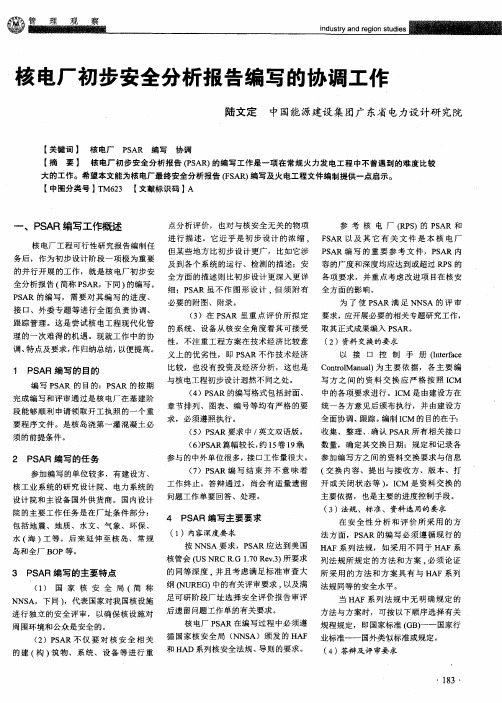
PSAR 的编 写,需要对 其 编写 的进度 、 必要的附图、附录 。
为 了 使 PSAR 满 足 NNSA 的 评 审
接 口、外 委专题 等进行全 面负责协 调、
(3)在 PSAR 里 重点评 价所 拟 定 要求 ,应开展必要 的相关专题研究工作 ,
跟 踪 管理。这是 尝试核 电工程 现代化管 的系统、设备从 核安全角度 看其可接 受 取 其 正 式 成 果 编 入 PSAR。
章节 排列、 图表 、编 号等均有 严格 的要 统 一 各 方 意 见 后 颁 布 执 行 , 并 由 建 设 方
段 能够顺利 申请领取开 工执照 的一个重
要 程序文件 。是核 岛浇 第一灌混 凝土必 求 ,必须遵照执行 。
全 面协 调、跟踪 。编制 ICM 的 目的在 于:
须 的前提条件 。
法 方面 ,PSAR 的编 写必 须遵 循现行 的
岛和全厂 BOP等 。
按 NNSA 要 求 ,PSAR 应 达 到 美 国 HAF系列法 规 ,如采 用不 同于 HAF系
核 管会 (US NRC R.G 1.70 Rev.3)所 要求 列法规 所规 定的方 法和方 案 ,必须论 证
3 PSAR编 写的主要特点
参加 编写的单位较 多,有 建设方、
(7)PSAR编 写结 束 并 不 意 味 着 (交换 内容、提 出与接 收 方、版本 、打
核 工业系统 的研究设计 院、 电力 系统的 工作 终止。答辩通过 , 尚会有适 量遗 留 开 或关 闭状态 等 o ICM 是 资料交换 的
设计 院和主设 备国外供 货商。 国内设 计 问题工作单要 回答 、处理 。
理的一次 难得 的机 遇。现就工作 中的协 性 ,不注重工程 方案在技 术经济 比较 意 (2)资料 交换的要求
核电厂运行安全常见问题及防控措施分析
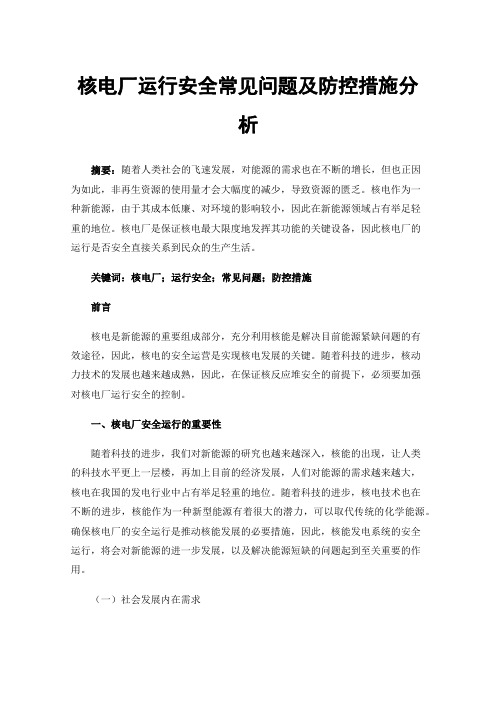
核电厂运行安全常见问题及防控措施分析摘要:随着人类社会的飞速发展,对能源的需求也在不断的增长,但也正因为如此,非再生资源的使用量才会大幅度的减少,导致资源的匮乏。
核电作为一种新能源,由于其成本低廉、对环境的影响较小,因此在新能源领域占有举足轻重的地位。
核电厂是保证核电最大限度地发挥其功能的关键设备,因此核电厂的运行是否安全直接关系到民众的生产生活。
关键词:核电厂;运行安全;常见问题;防控措施前言核电是新能源的重要组成部分,充分利用核能是解决目前能源紧缺问题的有效途径,因此,核电的安全运营是实现核电发展的关键。
随着科技的进步,核动力技术的发展也越来越成熟,因此,在保证核反应堆安全的前提下,必须要加强对核电厂运行安全的控制。
一、核电厂安全运行的重要性随着科技的进步,我们对新能源的研究也越来越深入,核能的出现,让人类的科技水平更上一层楼,再加上目前的经济发展,人们对能源的需求越来越大,核电在我国的发电行业中占有举足轻重的地位。
随着科技的进步,核电技术也在不断的进步,核能作为一种新型能源有着很大的潜力,可以取代传统的化学能源。
确保核电厂的安全运行是推动核能发展的必要措施,因此,核能发电系统的安全运行,将会对新能源的进一步发展,以及解决能源短缺的问题起到至关重要的作用。
(一)社会发展内在需求随着科学技术的飞速发展,世界上60多个国家和地区已经开始应用核电。
从全社会的角度来看,核电厂的安全是一种社会发展的内在需求,能够有效缓解环境压力,从而促进社会的健康发展。
(二)科技发展的需要核电是一种以科技为支撑的新能源,具有良好的经济性和清洁性能。
核能在全球范围内的应用越来越广泛,未来,核能发电的规模将会越来越大,而随着核能的发展,核能安全问题也越来越受到重视。
由于核能会对人类的生命和健康产生一定的危害。
因此,要确保核电行业的平稳、持续发展,就需要加强核电厂的安全运营管理工作,确保核电厂的安全运行符合有关规定。
这是现代科技发展的需要,同时也是为了保证核电厂的安全和稳定发展[1]。
核电厂运行安全常见问题及防控措施分析

核电厂运行安全常见问题及防控措施分析摘要:核能的出现有效解决了世界能源危机,但是核电厂运行过程中发生的事故却让人类在精神上留下了深刻的阴影。
自世界首个核电厂建成后,全球已经出现了好几起事故,所带来的损害巨大,而且会给子孙后代带来延续万年的影响,所以不能忽略核电厂运行过程中的安全问题,且有些看上去很小的问题常常会造成严重的安全隐患,继而造成无法挽回的结果。
因此,本文详细阐述了核电厂运行过程中常见的安全问题及防控措施,希望能对相关人员开展工作提供借鉴。
关键词:核电厂;运行安全;常见问题;防控措施前言由于环境的不断恶化,地球的资源日益匮乏,所以新能源开发势在必行,且核能是一种具有低成本、低污染的新兴能源,虽然核能能够有效地缓解世界的能源危机,但是核电厂的灾难却给人们的心灵带来了巨大的冲击,所以为加强核能安全管理,应当准确把握核电厂运行中的安全常见问题,进而本文将重点介绍核电厂的操作安全问题。
一、核电厂运行安全常见问题分析(一)人因失效有些核电厂虽然已经引进了人因管理理念,但还没有按规范进行落实。
针对国内某些核电厂的具体情况,可以总结出如下存在的问题:首先,相关的人员经验不足,造成了核电厂的低效运转;其次是由于某些核电厂建造中的遗留问题,或是由于设计上的问题所造成机械设备出现故障;再次,在核电厂的机器设备维修中人为失误的可能性很大;最后,核电厂工作人员的工作表现出了模棱两可、低级错误,最终导致核电厂在运行过程中出现安全事故的几率有所增加[1]。
(二)安全监管存有问题中国核电行业的部门结构较为复杂繁琐,而由国家领导的核能部门又是分散的,所以在核电厂的安全管理工作中,往往难以做到一个统一、集中的监管。
对核电厂来说,安全监管的质量是不容忽视的,在核电厂的运营过程中,若不能进行有效开展统一监管工作将不能保障核电厂安全运行。
(三)核系统失效问题由于环境的不断恶化,地球的资源日益匮乏,所以新能源开发势在必行,核能是世界上最重要的一种能源,其利用效率高,能够有效地解决我国目前的能源短缺问题,满足我国人民群众的日常生活和经济发展。
核电厂反应堆换料安全分析原理与实践研究
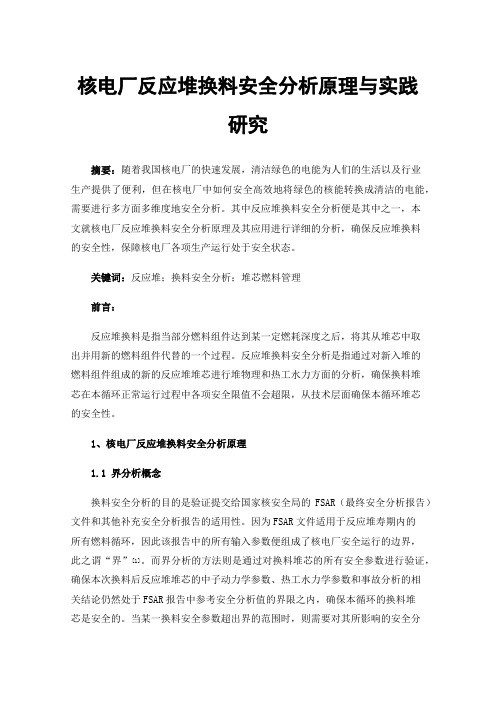
核电厂反应堆换料安全分析原理与实践研究摘要:随着我国核电厂的快速发展,清洁绿色的电能为人们的生活以及行业生产提供了便利,但在核电厂中如何安全高效地将绿色的核能转换成清洁的电能,需要进行多方面多维度地安全分析。
其中反应堆换料安全分析便是其中之一,本文就核电厂反应堆换料安全分析原理及其应用进行详细的分析,确保反应堆换料的安全性,保障核电厂各项生产运行处于安全状态。
关键词:反应堆;换料安全分析;堆芯燃料管理前言:反应堆换料是指当部分燃料组件达到某一定燃耗深度之后,将其从堆芯中取出并用新的燃料组件代替的一个过程。
反应堆换料安全分析是指通过对新入堆的燃料组件组成的新的反应堆堆芯进行堆物理和热工水力方面的分析,确保换料堆芯在本循环正常运行过程中各项安全限值不会超限,从技术层面确保本循环堆芯的安全性。
1、核电厂反应堆换料安全分析原理1.1界分析概念换料安全分析的目的是验证提交给国家核安全局的FSAR(最终安全分析报告)文件和其他补充安全分析报告的适用性。
因为FSAR文件适用于反应堆寿期内的所有燃料循环,因此该报告中的所有输入参数便组成了核电厂安全运行的边界,此之谓“界”[1]。
而界分析的方法则是通过对换料堆芯的所有安全参数进行验证,确保本次换料后反应堆堆芯的中子动力学参数、热工水力学参数和事故分析的相关结论仍然处于FSAR报告中参考安全分析值的界限之内,确保本循环的换料堆芯是安全的。
当某一换料安全参数超出界的范围时,则需要对其所影响的安全分析事故进行再分析以及再评价,确保该偏差仍然满足安全准则和设计基准的要求,或者为确保系统运行安全,需要根据实际情况适当修改换料设计、技术规格书和运行规程。
只有确保所有安全分析事故的安全限制和验收准则处于合理化状态,才能确保本循环换料堆芯的安全性。
1.2关键安全参数对于核电厂来讲,加强对反应堆换料安全分析非常重要,其中安全分析的原理包含很多内容。
第一,关键安全参数。
关键安全参数为那些与堆芯有关的安全参数,这些参数倘若有所变化,将可能影响正常运行和事故工况的后果。
核电厂安全分析报告的格式和内容

核电厂安全分析报告的格式和内容核电厂是以核能为主要能源 source 的电力发电厂。
核电站被认为是一种高风险的工业设施,因此必须进行安全分析。
核电厂安全分析报告需要包含的格式和内容主要有以下几个方面:1. 序言序言应为核电厂安全分析报告提供背景和目的。
它应该解释为什么进行这项分析,以及这项分析的目的是什么。
同时,应该提供报告撰写者的背景信息和报告使用者的受众信息。
2. 设施概述设施概述应该包括关于核电厂自身的信息。
这些信息包括核反应堆类型,工作方式,安全系统,设备,控制软件,追溯性等等。
同时也包括影响该设施的外部因素,例如天气,可能的恐怖袭击和自然灾害等。
3. 安全分析方法在核电站安全分析报告中,必须涵盖使用的安全分析方法和技术。
这些方法和技术可以涉及风险评估、可靠性分析和事件树分析等。
4. 事件描述这一部分应该描述可能会影响核电厂安全的事件和事故,包括短路、事故、极端天气等。
这些事件具体分析,包括发生的原因、可能的后果以及如何应对这些后果的措施也都需要在报告中详细说明。
5. 风险分析当在核电站运营中所有可能发生的事件进行了描述,需要对这些事件进行细致的风险分析。
这一部分包括所有可能的潜在危险或造成重大破坏的事件,以及这些事件产生的可能的风险等。
6. 结论和建议在核电站安全分析报告的结论部分,将对当前的情况进行概括和总结。
重点关注那些被认为是亟需修复或改进的问题,并提出针对问题的具体解决方法和建议以及预算方案等。
最后,在安全分析报告的末尾部分,可以添加参考文献列表,以便报告读者查阅相关文献。
这份报告应该是一个全面而且详细的文档,并能够为利益者们提供合适的信息,对核电站的安全性评估能够起到重要的作用。
核电厂职业危害分析报告

•引言•核电厂职业危害种类•核电厂职业危害来源•核电厂职业危害预防措施•结论和建议01引言背景随着核能技术的广泛应用,核电厂工作人员在生产过程中可能面临多种职业危害,如辐射、化学物质、噪声等。
因此,对核电厂职业危害进行深入分析具有重要的现实意义。
目的本报告旨在全面分析核电厂工作人员所面临的职业危害,并提出相应的预防和控制措施,以保障员工健康和安全。
报告目的和背景01核电厂是一种利用核能发电的工厂,通过核裂变或核聚变反应产生热能,驱动蒸汽轮机发电。
02核电厂通常包括反应堆、蒸汽轮机、发电机、冷却塔等主要设施,以及一系列辅助系统和设备。
03核电厂在运行过程中会产生大量的放射性物质和化学物质,对环境和工作人员造成潜在危害。
核电厂概述02核电厂职业危害种类核电厂工作人员可能暴露于一定程度的辐射环境中,长期或过量的辐射暴露可能对身体健康造成影响。
核电厂运行过程中产生大量热量,可能导致工作人员面临高温工作环境;同时,某些设备可能产生低温环境,造成低温暴露风险。
核辐射高温与低温物理危害化学危害0102机械伤害核电厂中的机械设备可能对工作人员造成夹伤、割伤等机械性伤害。
噪音与振动长期在噪音和振动的环境中工作可能对听力、神经系统和骨骼造成影响。
核电厂的电气设备可能引发电击事故,对工作人员的生命安全构成威胁。
电击强电磁场可能对工作人员的身体健康产生影响,如影响睡眠、造成头痛等不适症状。
电磁辐射核电厂工作的高压环境可能对工作人员的心理健康造成影响,如焦虑、抑郁等。
其他危害心理压力03核电厂职业危害来源放射性物质核电厂工作人员在处理放射性物质过程中,可能会接触到不同程度和类型的放射性物质,如铀、钚、铯等。
这些放射性物质可能对工作人员的健康造成潜在危害,如皮肤损伤、癌症、遗传疾病等。
辐射监测核电厂应建立完善的辐射监测系统,对工作人员和环境进行实时监测,确保辐射水平在安全范围内。
同时,应定期对监测设备进行校准和维护,确保数据的准确性和可靠性。
福岛核事故后核电厂安全改进行动分析

在2011年的3月,日本福岛最大的核电站发生核电爆炸事故,这给各大主要核电国家敲响了极大的警钟。
世界各大主要核电国家对其核电站的安全进行了检查与再评估,并且提出对核电站安全的升级改进计划和相应的措施。
该文对各大主要核电国家的核电站的升级改进工作,并且对核电站改进政策的内涵进行了阐述。
1 世界各国核安全检查和评价状况核电站安全检查与再评估行动提出了两点改进措施:其一是,对核电站和其设计标准是否符合进行了评估,其二是,对超设计标准的工作情况进行了具体的分析。
各个主要核电国家对核电站的安全评估方法基本上相同,假定把极端的自然现象施加给该核电站,如有严重威胁并且会导致严重的后果,然后进行重新评定该核电站的安全系数,以及对严重事故进行应对策略的制定及组织工作。
中国环境保护部联合相关部门,对运行核电厂开展了外部事件安全裕量评估。
改进要求提出后,环境保护部多次组织核设施营运单位讨论技术方案,及时了解实施进展,并多次对各核设施福岛事故后改进落实情况进行检查督导。
同时,环境保护部多次组织业内单位开展福岛核事故经验教训交流和研讨,积极开展国际交流合作,跟踪国际相关研究成果并及时反馈到国内业界[1]。
2 面对辅导核事故各国的改进行动2.1 法国改进行动在日本福岛核事故之后,法国颁布了一项国家计划,针对核事故产生辐射的应急响应。
法国在所有达到10km的场址、工厂和区域都签订了应急计划。
ASN从行政管理的加强、增设备用的手段、提高抗灾的能力、控制放射性的影响这4个大方向进行了整改要求,并提出以下几个方面的调整的措施:其一是,对有关防护放射性的关键设备、系统和建筑物进行了升级和改进;其二是,对这些关键设备、系统和建筑物进行后期的保护,使其能够正常的运转和使用[2]。
2.2 美国改进行动在日本福岛核事故之后,对已有的安全通风系统进行更换或者是改进,反应堆安装仪表用来检测应急状况下的水位情况,核电站必须能同时处理多个突发情况,以保证乏燃料和反应堆的冷却。
核电厂正常运行期间核安全监督管理基本问题分析及对策

核电厂正常运行期间核安全监督管理基本问题分析及对策摘要:自福岛核泄漏发生以后,世界各国越来越重视核安全问题。
严重核事故不仅致人死亡,还会造成重大财产损失、环境污染、生活家园破坏等问题。
为此,核电厂必须做好其正常运行期间核安全的监督管理工作,本文主要对核电厂正常运行期间核安全监督管理中存在的基本问题加以分析,从而提出相应的解决对策。
关键词:核电厂;核安全;监督管理;基本问题;对策前言核电厂正常运行工况是核电站一年中工作时间最为长的时期,这一时期核燃料全部装载于堆芯中,核电站的主回路压力边界处于完全封闭状态,为防止放射性外泄所设的三道屏障也处于完全封闭状态,然而用于对于三道屏障完整性进行保护的安全系统、相关的辅助支持系统及缓解与为限制事故后果的而专门设置的安全设施等,需要派遣专人进行维护与处理。
为确保核电厂正常运行期间的核安全,核电厂应做好安全监督管理工作,结合自身的具体情况,采用相应手段提高现场辐射安全监督的有效性,通过制定科学的、合理的管理制度,从而在极大程度上提高核安全监督管理的效果与质量。
1.核电厂正常运行期间核安全监督管理基本问题核电厂正常运行期间核安全监督管理工作的开展要求能够取得并向公众与核安全监管当局保证核电站的营运和核安全的要求相符合,并严格遵守核安全的管理标准、法规及运行技术规格书,确保核电站的安全运行,从而保证机组运行处于安全分析报告中所要求的安全水平上,能够履行其对公众和社会所做出的承诺[1]。
核电站正常运行期间核安全监督管理基本问题包括以下几点:(1)保证核电站在设计水平上能够安全运行,从而对核电站的运行安全业绩加以不断改进及合理提升,在最大程度上降低事故发生的可能性,并通过采取相应的技术手段与组织方面在限制与缓解存在的安全隐患;可以说是,核电站正常运行期间核安全监督管理的主要任务就是保证核电站在设计水平上能够安全运行;(2)核电站应严格遵循核安全的相关管理规定及标准,在技术层面与组织管理层面上制定一系列的解决措施,做到实时的监督与管理核安全管理工作,并能够正确的、有效的执行。
核电厂安全分析报告的格式和内容

国际原子能机构安全标准
通过国际标准实现安全 虽然安全是国家的责任,但是国际安全标准和安全方案可以促进协调
一致,有助于确保核和辐射相关技术的安全使用,并有利于国际技术合作 和贸易。
安全标准也为各国履行其国际义务提供支持。一项一般的国际义务是 一国不得从事可对另一国造成损害的活动。在国际安全相关公约中为缔约 国规定了更具体的义务。经国际商定的原子能机构安全标准为各国表明其 本国正在履行这些义务提供了依据。
国际原子能机构 安全标准
保护人类与环境
号
国际原子能机构安全相关出版物
国际原子能机构(原子能机构)安全标准
根据原子能机构《规约》第三条的规定,原子能机构受权制定或采取旨在保护 健康及尽量减少对生命与财产的危险的安全标准,并规定适用这些标准。
下述国家是国际原子能机构的成员国:
阿富汗 阿尔巴尼亚 阿尔及利亚 安哥拉 阿根廷 亚美尼亚 澳大利亚 奥地利 阿塞拜疆 孟加拉国 白俄罗斯 比利时 贝宁 玻利维亚 波斯尼亚和黑塞哥维那 博茨瓦纳 巴西 保加利亚 布基纳法索 喀麦隆 加拿大 中非共和国 乍得 智利 中国 哥伦比亚 哥斯达黎加 科特迪瓦 克罗地亚 古巴 塞浦路斯 捷克共和国 刚果民主共和国 丹麦 多米尼加共和国 厄瓜多尔 埃及 萨尔瓦多 厄立特里亚 爱沙尼亚 埃塞俄比亚 芬兰 法国 加蓬 格鲁吉亚 德国 加纳
核电厂安全分析报告的 格式和内容
安全导则
国际原子能机构 维也纳·2006 年
版权说明
国际原子能机构的所有科学和技术出版物均受 1952 年(伯尔尼)通过 并于 1972 年(巴黎)修订的《万国版权公约》之条款的保护。自那时以来, 世界知识产权组织(日内瓦)已经扩大了这一版权,以包括电子形式和虚 拟形式的知识产权。必须获得许可而且通常需要签订版税协议方能使用原 子能机构印刷形式和电子形式出版物中所载全部或部分内容。欢迎有关非 商业性翻印和翻译的建议并将在个案基础上予以考虑。询问事宜应通过电 子邮件地址 sales.publications@ 发至原子能机构出版科或按以下地 址邮寄:
核电厂安全事故起因剖析与防范对策

核电厂安全事故起因剖析与防范对策核电厂作为一种清洁、高效的能源来源,受到了广泛的应用和重视。
然而,核电厂安全事故的发生仍然是一种非常严重的问题,它不仅威胁着核电站的职工生命安全,还可能造成巨大的环境破坏和人类健康风险。
为了保障核电厂的运行安全,我们需要深入剖析核电厂安全事故的起因,并提出相应的防范对策。
首先,我们来分析核电厂安全事故的起因。
核电厂安全事故往往由多种因素共同作用导致。
一方面,人为因素是核电厂安全事故的主要原因之一。
操作失误、人员疏忽、技术不合格或不足等问题可能导致设备故障、燃料泄漏、放射性物质泄露等安全隐患。
另一方面,设备故障和自然灾害也是核电厂事故发生的因素。
例如,设备老化、材料缺陷、电网故障等可能引发设备失效,而地震、洪水、风暴等自然灾害则可能对核电厂的结构和运行产生直接影响。
基于以上分析,我们可以提出一些防范核电厂安全事故的对策。
首先,加强人员培训和管理是非常重要的。
核电厂职员需要接受全面的培训,熟悉操作规程和安全程序,提高其意识和技能水平。
同时,应建立完善的管理体系,确保工作人员的责任意识和工作纪律,严格按照标准操作规程执行工作。
其次,建立并落实科学的安全管理制度。
核电厂应制定详细的安全规章制度和应急预案,并进行定期演练和考核。
从源头上预防事故的发生,加强设备维护和检修,确保设备运行的可靠性和稳定性。
此外,加强对设备老化和缺陷的监控和改善,及时发现并解决问题。
再次,加强核电厂的监控和检测体系。
通过使用先进的监测设备和技术手段,对设备运行状态、放射性物质泄漏等进行实时监测,及时发现异常情况并采取合适的应对措施。
最后,加强对核电厂周边环境的保护。
核电厂应建立良好的社会沟通机制,与周边居民和相关部门保持密切联系,及时传递相关信息和预警,做好应对措施,确保核电厂事故发生时能够最大限度地保护周边居民的生命和财产安全。
除了以上对策,我们还需要借鉴其他国家和地区的成功经验。
例如,法国的核电厂在安全管理方面积累了丰富的经验,其核电厂的安全记录相对较好。
基于STPA的核电厂仪控系统安全分析研究

该核电厂仪控系统涵盖了从反应堆控制到 废水处理的所有核心系统,确保了核电厂 的稳定运行。
该核电厂仪控系统采用了多种安全 机制,如故障检测、冗余控制和紧 急停堆等。
基于STPA的核电厂仪控系统安全分析过程
采用STPA方法对仪控系统的安全性能进行定量评估。
通过模拟实验和实际数据采集,评估仪控系统在各种 场景下的性能。
评估分析结果
根据分析结果,评估核电厂仪控系统的安全性,识别潜 在的安全隐患并提出改进措施。
04
基于STPA的核电厂仪控系统安全分 析模型
基于STPA的核电厂仪控系统安全分析模型构建
• STPA方法概述:STPA(System-Theoretic Process Analysis)是一种系统理论的过程分析方法,适用于 分析核电厂仪控系统的安全性能。
针对仪控系统中存在的安全隐患 和薄弱环节,深入研究并采取有 效的措施来增强系统的安全性。
将人工智能、大数据等先进技术 引入STPA方法中,实现智能化 安全分析,提高分析效率和精度 。
加强与其他领域和行业的合作, 共同探讨STPA方法在其他领域 的应用和拓展,推动该方法的发 展和应用。
THANKS
谢谢您的观看
建议加强应急预案的制定和实施,提高应对突发 事件的能力。
建议对仪控系统的关键设备进行定期检测和维护 ,避免因设备故障导致的安全事故。
06
结论与展望
研究结论
01
STPA方法的有效性
本研究成功应用STPA方法对核电厂仪控系统进行了安全分析,验证了
该方法的有效性和可行性。
02
系统脆弱性
通过对仪控系统的深入分析,发现系统存在一些薄弱环节和安全隐患
STPA基于事件模型进行分析,通过构 建事件模型,识别出系统中的关键事 件和过程,并分析这些事件和过程之 间的相互关系和影响。
- 1、下载文档前请自行甄别文档内容的完整性,平台不提供额外的编辑、内容补充、找答案等附加服务。
- 2、"仅部分预览"的文档,不可在线预览部分如存在完整性等问题,可反馈申请退款(可完整预览的文档不适用该条件!)。
- 3、如文档侵犯您的权益,请联系客服反馈,我们会尽快为您处理(人工客服工作时间:9:00-18:30)。
RegulatoryDocumentRD–310Safety Analysis for Nuclear Power Plants February 2008CNSC REGULATORY DOCUMENTSThe Canadian Nuclear Safety Commission (CNSC) develops regulatory documents under the authority of paragraphs 9(b) and 21(1)(e) of the Nuclear Safety and Control Act (NSCA).Regulatory documents provide clarifications and additional details to the requirements set out in the NSCA and the regulations made under the NSCA, and are an integral part of the regulatory framework for nuclear activities in Canada.Each regulatory document aims at disseminating objective regulatory information to stakeholders, including licensees, applicants, public interest groups and the public on a particular topic to promote consistency in the interpretation and implementation of regulatory requirements.A CNSC regulatory document, or any part thereof, becomes a legal requirement when it is referenced in a licence or any other legally enforceable instrument.Regulatory DocumentRD–310SAFETY ANALYSIS FOR NUCLEAR POWER PLANTSPublished by theCanadian Nuclear Safety CommissionFebruary 2008REGULATORY DOCUMENTRD–310SAFETY ANALYSIS FOR NUCLEAR POWER PLANTS Published by the Canadian Nuclear Safety Commission© Minister of Public Works and Government Services Canada 2008Extracts from this document may be reproduced for individual use without permission, provided the source is fully acknowledged. However, reproduction in whole or in part for purposes of resale or redistribution requires prior written permission from the Canadian Nuclear Safety Commission.Catalogue number: CC173-3/4-310E-PDFISBN 978-0-662-47989-5Ce document est également disponible en français sous le titre Analyses de la sûreté pour les centrales nucléaires.Document availabilityThe document can be viewed on the CNSC web site at www.nuclearsafety.gc.ca. Copies may be ordered in English or French using the contact information below:Canadian Nuclear Safety CommissionP.O. Box 1046, Station B280 Slater StreetOttawa, Ontario, CANADA, K1P 5S9Telephone: 613-995-5894 or 1-800-668-5284 (Canada only)Facsimile: 613-992-2915E-mail: info@cnsc-ccsn.gc.caPREFACEThis regulatory document was developed pursuant to the requirements and obligations set forth in the General Nuclear Safety and Control Regulations and in the Class I Nuclear Facilities Regulations, where a safety analysis report demonstrating the safety of the nuclear facility must be submitted to the Canadian Nuclear Safety Commission (CNSC).The document identifies high-level regulatory information for a nuclear power plant licence applicant’s preparation and presentation of a safety analysis. The information required adheres to high standards and is consistent with modern national and international practices addressing issues and elements that control and enhance nuclear safety. In particular, it establishes a more modern risk-informed approach to the categorization of accidents, one that considers a full spectrum of possible events including the events of greatest consequence to the public.The CNSC expects proponents and applicants for new reactor licences to immediately apply this regulatory document in new-build submissions. In the context of existing reactors, CNSC expects the licensees to apply this document, in a graduated manner, to all relevant programs in future submissions.TABLE OF CONTENTS1.0PURPOSE (1)2.0SCOPE (1)3.0RELEVANT LEGISLATION (1)4.0SAFETY ANALYSIS OBJECTIVES (2)5.0SAFETY ANALYSIS REQUIREMENTS (3)5.1Responsibility (3)5.2Events to be Analyzed (3)5.2.1Identifying Events (3)5.2.2Scope of Events (3)5.2.3Classification of Events (4)5.3Acceptance Criteria (4)5.3.1Normal Operation (4)5.3.2Anticipated Operational Occurrences and Design Basis Accidents (4)5.3.3Beyond Design Basis Accidents (5)5.3.4Acceptance Criteria for AOOs and DBAs (5)5.4Safety Analysis Methods and Assumptions (5)5.4.1General (5)5.4.2Analysis Method (6)5.4.3Analysis Data (6)5.4.4Analysis Assumptions (7)5.4.5Computer Codes (7)5.4.6Conservatism in Analysis (7)5.5Safety Analysis Documentation (7)5.6Safety Analysis Review and Update (8)5.6.1Review of Safety Analysis Results (8)5.6.2Update of Safety Analysis (8)5.7Quality of Safety Analysis (9)GLOSSARY (11)ASSOCIATED DOCUMENTS (13)SAFETY ANALYSIS FOR NUCLEAR POWER PLANTS1.0 PURPOSEThe purpose of this regulatory document is to help assure that during the construction,operation or decommissioning of a nuclear power plant (NPP), adequate safety analyses are completed by, or on behalf of, the applicant or licensee in accordance with theNuclear Safety and Control Act (NSCA) and regulatory requirements.2.0 SCOPEThis document sets out the requirements related to safety analysis, including the selection of events to be analyzed, acceptance criteria, safety analysis methods, and safety analysis documentation and review.LEGISLATION3.0 RELEVANTThe relevance of the NSCA and the regulations made under the NSCA to this regulatory document is as follows:1.Subsection 24(4) of the NSCA provides that the Commission may only issue, renewor amend licences if the licensee or the applicant is (a) qualified to carry on theactivity that the licence authorizes the licensee to carry on, and (b), in carrying outthat activity, make adequate provision for the protection of the environment, thehealth and safety of persons and the maintenance of national security and measuresrequired to implement international obligations to which Canada has agreed;2.Subsection 24(5) of the NSCA authorizes the Commission to include in a licenceany term or condition that the Commission considers necessary for the purposes ofthe Act;3.Paragraph 3(1)(i) of the General Nuclear Safety and Control Regulations providesthat an application for a licence shall contain, in addition to other information, “adescription and the results of any test, analysis or calculation performed tosubstantiate the information included in the application”;4.Paragraph 5(f) of the Class I Nuclear Facilities Regulations provides that anapplication for a licence to construct a Class I nuclear facility shall contain, inaddition to other information, information on “a preliminary safety analysis reportdemonstrating the adequacy of the design of the nuclear facility”;5.Paragraph 5(i) of the Class I Nuclear Facilities Regulations provides that anapplication for a licence to construct a Class I nuclear facility shall contain, inaddition to other information, information on “the effects on the environment andthe health and safety of persons that may result from the construction, operation anddecommissioning of the nuclear facility…”;6.Paragraph 6(c) of the Class I Nuclear Facilities Regulations provides that anapplication for a licence to operate a Class I nuclear facility shall contain, inaddition to other information, information on “a final safety analysis reportdemonstrating the adequacy of the design of the nuclear facility”;7.Paragraph 6(h) of the Class I Nuclear Facilities Regulations provides that anapplication for a licence to operate a Class I nuclear facility shall contain, inaddition to other information, information on “the effects on the environment andthe health and safety of persons that may result from the operation anddecommissioning of the nuclear facility…”; and8.Paragraph 7(f) of the Class I Nuclear Facilities Regulations provides that anapplication for a licence to decommission a Class I nuclear facility shall contain, inaddition to other information, information on “the effects on the environment andthe health and safety of persons that may result from the decommissioning of thenuclear facility…”OBJECTIVESANALYSIS4.0 SAFETYSafety analysis is an essential element of a safety assessment. It is an analytical studyused to demonstrate how safety requirements are met for a broad range of operatingconditions and various initiating events. Safety analysis involves deterministic andprobabilistic analyses in support of the siting, design, commissioning, operation ordecommissioning of a nuclear power plant. The requirements for probabilistic safetyassessment (PSA) for NPPs are provided in regulatory standard S-294, ProbabilisticSafety Assessment (PSA) for Nuclear Power Plants. Regulatory Document RD-310focuses on the deterministic safety analysis used in the evaluation of event consequences.The objectives of deterministic analysis are to:1.Confirm that the design of a nuclear power plant meets design and safetyrequirements;2.Derive or confirm operational limits and conditions that are consistent with thedesign and safety requirements for the NPP;3.Assist in establishing and validating accident management procedures andguidelines; and4.Assist in demonstrating that safety goals, which may be established to limit the risksposed by the nuclear power plant, are met.This document identifies high-level requirements for conducting and presenting a safety analysis, taking into account best national and international practices.5.0 SAFETY ANALYSIS REQUIREMENTS5.1 ResponsibilityThe licensee is responsible for ensuring that the safety analysis meets all regulatoryrequirements. The licensee shall:1.Maintain adequate capability to perform or procure safety analysis; 2.Establish a formal process to assess and update safety analysis, which takes into account operational experience, research findings and identified safety issues; and 3. Establish and apply a formal quality assurance (QA) process that meets the QAstandards established for safety analysis in Canadian Standards Association (CSA)publication N286.7-99, Quality Assurance of Analytical, Scientific and DesignComputer Programs for Nuclear Power Plants .5.2 Events to be Analyzed5.2.1 Identifying EventsThe licensee shall use a systematic process to identify events, event sequences, and event combinations (“events” hereafter in this document) that can potentially challenge thesafety or control functions of the NPP. This process shall be based on regulatoryrequirements and guidance, past licensing precedents, operational experience,engineering judgment, results of deterministic and probabilistic assessments, and anyother systematic reviews of the design.The identification of events shall account for all operating modes, and the list ofidentified events shall be reviewed for completeness during the design and analysisprocess and modified as necessary.In addition to events that could challenge the safety or control functions of the NPP,safety analysis shall be performed for normal operation.5.2.2 Scope of EventsThe list of events identified for the safety analysis shall include all credible:1.Component and system failures or malfunctions; 2.Operator errors; and 3. Common-cause internally and externally initiated events.A cut-off frequency shall be selected so that events with a frequency of occurrence lessthan the cut-off limit provide only a negligible contribution to the overall risk posed bythe NPP. The elimination of such events from the analysis scope shall be justified and the reasons for eliminating them documented.5.2.3 Classification of EventsThe identified events shall be classified, based on the results of probabilistic studies and engineering judgement, into the following three classes of events:1.Anticipated Operational Occurrences (AOOs) include all events with frequencies ofoccurrence equal to or greater than 10-2 per reactor year;2.Design Basis Accidents (DBAs) include events with frequencies of occurrenceequal to or greater than 10-5 per reactor year but less than 10-2 per reactor year; and3.Beyond Design Basis Accidents (BDBAs) include events with frequencies ofoccurrence less than 10-5 per reactor year.Other factors to be considered in the event classification are any relevant regulatoryrequirements or historical practices. Events with a frequency on the border between two classes of events, or with substantial uncertainty over the predicted event frequency, shall be classified into the higher frequency class.Credible common-cause events shall also be classified within the AOO, DBA and BDBA classes.Criteria5.3 AcceptanceOperation5.3.1 NormalAnalysis for normal operation of the NPP, performed during the design phase, shalldemonstrate that:1.Radiological doses to workers and members of the public are within the limitsacceptable to the CNSC; and2.Releases of radioactive material into the environment fall within the allowablelimits for normal operation.5.3.2 Anticipated Operational Occurrences and Design Basis AccidentsAnalysis for AOOs and DBAs shall demonstrate that:1.Radiological doses to members of the public do not exceed the established limits;and2.The derived acceptance criteria, established in accordance with 5.3.4 are met.Basis AccidentsDesign5.3.3 BeyondAnalysis for BDBAs shall be performed as part of the safety assessment to demonstrate that:1.The nuclear power plant as designed can meet the established safety goals; and2.The accident management program and design provisions, put in place to handle theaccident management needs, are effective.5.3.4 Acceptance Criteria for AOOs and DBAsQualitative acceptance criteria shall be established for each AOO and DBA to confirmthe effectiveness of plant systems in maintaining the integrity of physical barriers against releases of radioactive material. These qualitative acceptance criteria shall satisfy thefollowing general principles:1.Avoid the potential for consequential failures resulting from an initiating event;2.Maintain the structures, systems and components in a configuration that permits theeffective removal of residual heat;3.Prevent development of complex configurations or physical phenomena that cannotbe modeled with high confidence; and4.Be consistent with the design requirements for plant systems, structures andcomponents.To demonstrate that these qualitative acceptance criteria applicable to the analyzed AOO or DBA are met, quantitative derived acceptance criteria shall be identified prior toperforming the analysis. Such derived acceptance criteria shall be supported byexperimental data.The results of safety analysis shall meet appropriate derived acceptance criteria withmargins sufficient to accommodate uncertainties associated with the analysis.The analysis shall be performed for the event that poses the most challenges indemonstrating the meeting of derived acceptance criteria (i.e., the limiting event in anevent category).5.4 Safety Analysis Methods and Assumptions5.4.1 GeneralThe analysis shall provide the appropriate level of confidence in demonstratingconformity with the acceptance criteria. To achieve the appropriate level of confidence, the safety analysis shall:1.Be performed by qualified analysts in accordance with an approved QA process;2.Apply a systematic analysis method;e verified data;e justified assumptions;e verified and validated models and computer codes;6.Build in a degree of conservatism; and7.Be subjected to a review process.Method5.4.2 AnalysisThe analysis method shall include the following elements:1.Identifying the scenarios to be analyzed as required to attain the analysis objectives;2.Identifying the applicable acceptance criteria, safety requirements, and limits;3.Identifying the important phenomena of the analyzed event;4.Selecting the computational methods or computer codes, models, and correlationsthat have been validated for the intended applications;5.Defining boundary and initial conditions;6.Conducting calculations, including sensitivity cases, to predict the event transient,starting from the initial steady state up to the pre-defined end-state;7.Accounting for uncertainties in the analysis data and models;8.Verifying calculation results for physical and logical consistency; and9.Processing and documenting the results of calculations to demonstrate conformancewith the acceptance criteria.5.4.3 AnalysisDataThe safety analysis shall be based on complete and accurate design and operational information.The boundary and initial conditions used as the analysis input data shall:1.Reflect accurately the NPP configuration;2.Account for the effects of aging of systems, structures and components;3.Account for various permissible operating modes; and4.Be supported by experimental data, where operational data is not available. Significant uncertainties in analysis data, including those associated with nuclear power plant performance, operational measurements, and modeling parameters, shall be identified.5.4.4 AnalysisAssumptionsAssumptions made to simplify the analysis, as well as assumptions concerning theoperating mode of the nuclear power plant, the availability and performance of thesystems, and operator actions, shall be identified and justified.The analysis of AOO and DBA shall:1.Apply the single-failure criterion to all safety systems and their support systems;2.Account for consequential failures that may occur as a result of the initiating event;3.Credit actions of systems only when the systems are qualified for the accidentconditions, or when their actions could have a detrimental effect on theconsequences of the analyzed accident;4.Account for the possibility of the equipment being taken out of service formaintenance; and5.Credit operator actions only when there area)unambiguous indications of the need for such actions,b)adequate procedures and sufficient time to perform the required actions, andc)environmental conditions that do not prohibit such actions.For the analysis of BDBA, it is acceptable to use a more realistic analysis methodology consisting of assumptions which reflect the likely plant configuration, and the expected response of plant systems and operators in the analysed accident.Codes5.4.5 ComputerComputer codes used in the safety analysis shall be developed, validated, and used inaccordance with a quality assurance program that meets the requirements of CSAN286.7-99.5.4.6 Conservatism in AnalysisThe safety analysis shall build in a degree of conservatism to off-set any uncertaintiesassociated with both NPP initial and boundary conditions and modeling of nuclear power plant performance in the analyzed event. This conservatism shall depend on event class, and shall be commensurate with the analysis objectives.5.5 Safety Analysis DocumentationThe safety analysis documentation shall be comprehensive and sufficiently detailed toallow for a conclusive review. The document shall include:1.The technical basis for the analyzed event and key phenomena and processes;2. A description of the analyzed facility, including important systems and theirperformance, as well as operator actions;rmation describing the analysis method and assumptions;4. A description of the assessments of code applicability for the analyzed event andcomputer code uncertainty; and5. A description of the analysis results in a manner that facilitates their understandingand the drawing of conclusions related to conformance with acceptance criteria.Analysis documentation shall facilitate the update of the analysis when new resultsbecome available.5.6 Safety Analysis Review and Update5.6.1 Review of Safety Analysis ResultsThe licensee shall systematically review the safety analysis results to ensure that they are correct and meet the objectives set for the analysis. The results shall be assessed against the relevant requirements, applicable experimental data, expert judgment, andcomparison with similar calculations and sensitivity analyses.The licensee shall review the analysis results using one or more of the followingtechniques, depending on the objectives of the analysis:1.Supervisory review;2.Peer review;3.Independent review by qualified individuals; and4.Independent calculations using alternate tools and methods to the extent practicable.5.6.2 Update of Safety AnalysisThe safety analysis shall be periodically reviewed and updated to account for changes in NPP configuration, conditions (including those due to aging), operating parameters and procedures, research findings, and advances in knowledge and understanding of physical phenomena, in accordance with CNSC regulatory standard S-99, Reporting Requirements for Operating Nuclear Power Plants.In addition to periodic updates, the safety analysis shall also be updated following thediscovery of information that may reveal a hazard that is different in nature, greater inprobability, or greater in magnitude than was previously presented to the CNSC in thelicensing documents.5.7 Quality of Safety AnalysisSafety analysis shall be subject to a comprehensive QA program applied to all activities affecting the quality of the results. The QA program shall identify the quality assurance standards to be applied and shall include documented procedures and instructions for the complete safety analysis process, including, but not limited to:1.Collection and verification of NPP data;2.Verification of the computer input data;3.Validation of NPP and analytical models;4.Assessment of simulation results; and5.Documentation of analysis results.GLOSSARYAcceptance criteriaSpecified bounds on the value of a functional or conditional indicator used to assess the ability of a system, structure or component to meet its design and safety requirements.AccidentAny unintended event, including operating errors, equipment failures or other mishaps, the consequences or potential consequences of which are not negligible from the point of view of protection or safety.Anticipated operational occurrence (AOO)An operational process deviating from normal operation that is expected to occur once or several times during the operating lifetime of the NPP but which, in view of the appropriate design provisions, does not cause any significant damage to items important to safety nor lead to accident conditions.Best estimate methodA method designed to give realistic results.Beyond design basis accident (BDBA)Accident conditions less frequent and more severe than a design basis accident. A BDBA may or may not involve core degradation.Common causeA cause for a concurrent failure of two or more structures, systems or components, such as natural phenomena (earthquakes, tornadoes, floods, etc.), design deficiency, manufacturing flaws, operation and maintenance errors, human-induced destructive events and others. Conservative methodA method deliberately leading to results that are intended to be limiting relative to specified acceptance criteria.Design basis accident (DBA)Accident conditions against which an NPP is designed according to established design criteria, and for which the damage to the fuel and the release of radioactive material are kept within authorized limits.Deterministic safety analysisAn analysis of nuclear power plant responses to an event, performed using predetermined rules and assumptions (e.g., those concerning the initial operational state, availability and performance of the systems and operator actions). Deterministic analysis can use either conservative or best estimate methods.Event categoryA group of events characterized by the same, or similar, cause and similarity in the governing phenomena.Normal operationOperation of an NPP within specified operational limits and conditions including start-up, power operation, shutting down, shutdown, maintenance, testing and refuelling.NPPSee nuclear power plant.Nuclear power plantAlso referred to as an NPP, a nuclear power plant is any fission-reactor installation that has been constructed to generate electricity on a commercial scale. A nuclear power plant is a Class IA nuclear facility, as defined in the Class I Nuclear Facilities Regulations.Operational limits and conditionsA set of rules setting forth parameter limits or conditions that ensures the functional capability and the performance levels of equipment for safe operation of an NPP.Operational modeOperational mode may include start-up, operation at various power levels, shutting down, shutdown, maintenance, testing and refuelling.Safety analysisEvaluation of the potential hazards associated with the conduct of a proposed activity.Safety assessmentAssessment of all aspects of the siting, design, commissioning, operation or decommissioning of an authorized facility that is relevant to safety.Sensitivity analysisA quantitative examination of how the behaviour of a system varies with change, usually in the values of the governing parameters.Single-failure criterionThe criterion used to determine whether a system is capable of performing its function in the presence of a single failure.Structures, systems and components (SSCs)A general term encompassing all of the elements (items) of a facility or activity which contribute to protection and safety, except human factors.Support features of safety systemsThe collection of equipment that provides services such as cooling, lubrication and energy supply required by the protection system and the safety actuation systems.February 2008 RD–310ASSOCIATED DOCUMENTS1.Probabilistic Safety Assessment (PSA) for Nuclear Power Plants, S-294. Canadian NuclearSafety Commission, Ottawa, 2005.2.Quality Assurance of Analytical, Scientific and Design Computer Programs for NuclearPower Plants. N286.7-99. Canadian Standards Association, 2003.3.Reporting Requirements for Operating Nuclear Power Plants, S-99. Canadian NuclearSafety Commission, Ottawa, 2003.13。
